Oxygen concentrators are medical devices designed to deliver concentrated oxygen to patients with certain breathing related disorders. These are life-saving devices, and it is therefore important that you keep your oxygen concentrators running efficiently. For this, you will need to clean your oxygen concentrator regularly.
To clean an oxygen concentrator, wipe the housing with a damp cloth dipped in a mild detergent and let it dry. To clean the oxygen tubing and the nasal cannulae, wipe with a mild soapy solution and then with warm water. Place the filter under running water and then air dry. Clean the humidifier with soapy water, rinse under warm running water, and disinfect with a vinegar solution.
While the general maintenance rules for oxygen concentrators are largely similar between brands, there are sometimes differences between individual brands that you need to be aware of. In this article, we address both the general maintenance principles for oxygen concentrators and provide specific details for some popular brands (Invacare, DeVilbliss, Visionaire, Inogen and Phillips) as well. Let’s get started.
What exactly is an oxygen concentrator?
As the name implies, an oxygen concentrator is a device that simply accumulates oxygen from the air and delivers it to your lungs in a higher concentration.
The air in our atmosphere has about 78% Nitrogen and about 21% oxygen. Usually, this concentration is enough for your lungs to absorb and maintain proper saturation of oxygen in your blood.
If you have any disease that affects your breathing (or sometimes your circulation), however, then the concentration of oxygen in the air around you may not be sufficient to maintain enough oxygen saturation in your blood.
In this case, you need to be provided oxygen at a higher concentration than normal. In a hospital, this is typically arranged by giving you concentrated oxygen from an oxygen cylinder. Larger hospitals may even have a central supply system where the oxygen comes from certain chemical reactions occurring in an ‘oxygen plant’.
At your home, however, you do not have the privilege of an oxygen plant, nor is it always feasible to purchase and use oxygen cylinders. This is where oxygen concentrators come into play.
Instead of using complex chemical reactions to generate oxygen, oxygen concentrators simply take oxygen that is already present in the air and remove other gases so you can have a higher concentration of the gas to breathe in.
Why should you clean an oxygen concentrator?
The single most important reason to clean your oxygen concentrator is for hygiene and safety.
Your oxygen concentrator is responsible for directly delivering clean oxygen to your respiratory system. A dirty concentrator can be a breeding ground for micro-organisms, which will be able to directly enter your body through the air you breathe.
Regularly cleaning the concentrator, humidifier, the oxygen tubing, and nasal cannula/mask is essential to prevent that from happening.
Cleaning your concentrator will also increase its lifespan and ensure that your device is working optimally.
Parts of an Oxygen Concentrator
Before you know the details of how to clean an oxygen concentrator, it is a good idea to know what your concentrator unit actually consists of.
- The concentrator cabinet:
The first thing you should be familiar with is the concentrator cabinet itself. This is basically the main part of the device assembly. It also includes the filter, which is the part of your oxygen concentrator that removes impurities and other gases from the air.
- The Humidifier
The humidifier essentially adds moisture to concentrated oxygen that your device has generated and prevents your internal respiratory passage from being dry. However, it is only required if your physician has prescribed more than 4 liters per minute of oxygen.
- Oxygen Tubing
The concentrated oxygen from your device reaches you via this tube. This could range from a few to several feet long.
- Nasal Cannulae (or facemask)
These are small tubes that go into each of your nostrils. They help direct the oxygen from the tubing into your nose.
Sometimes, the cannulae are too small to pass the amount of air that your lungs need. In that case, your oxygen tubing may be connected to an oxygen facemask instead.
All of these parts are important for your concentrator assembly to work efficienctly. In the coming section, we are going to look into how each of these parts should be cleaned.
How to clean an oxygen concentrator (Exterior)
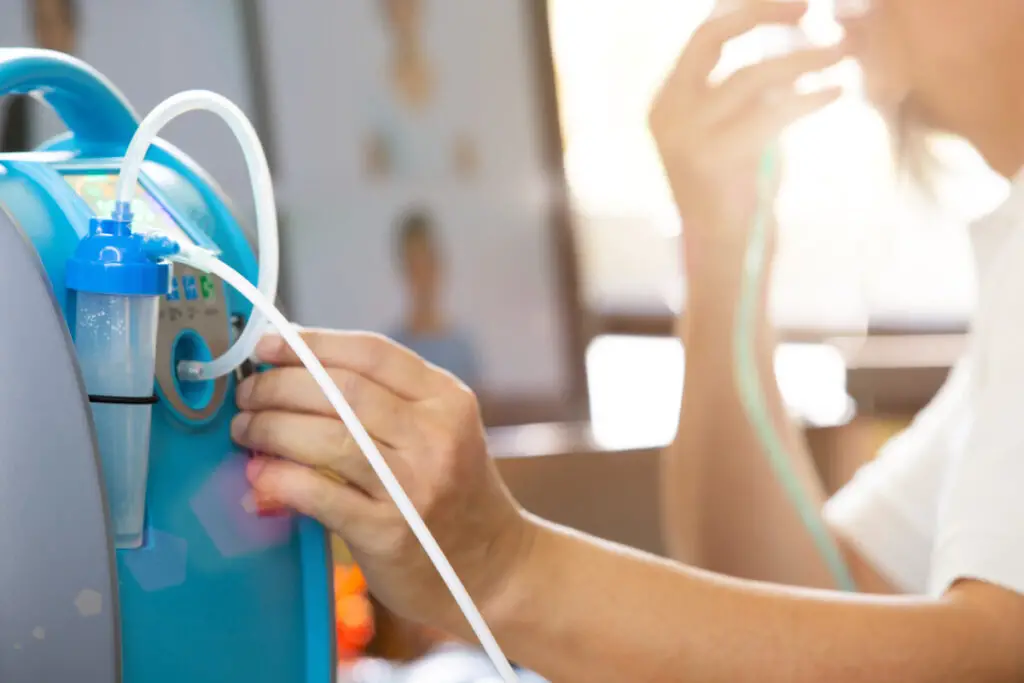
Almost all brands of oxygen concentrators require you to NOT open the main cabinet. All you are required to do is clean the exterior properly. For this, follow these steps:
- Turn the concentrator off.
- Unplug the device from the power outlet. This is to ensure you are safe from any possible electrical shock.
- Take a clean piece of cloth and dip it in soapy water. Please ensure that the soap or detergent used is mild.
- Rinse the cloth thoroughly. It is an extremely important step as water getting into the crevices of your device could damage it irreversibly. It could even void your device’s warranty, so make sure the cloth is just damp, and not wet.
- Gently wipe the surfaces of the device with the cloth.
- After you are done wiping the device, dip the cloth again in plain water. Rinse it well, and repeat wiping all the surfaces of your concentrator again. This is to remove the layer of soap from your device’s surface.
- Once the whole device is dry, you can reconnect it and use it again.
It is generally recommended that you clean your concentrator cabinet once a week.
How to clean an oxygen concentrator filter
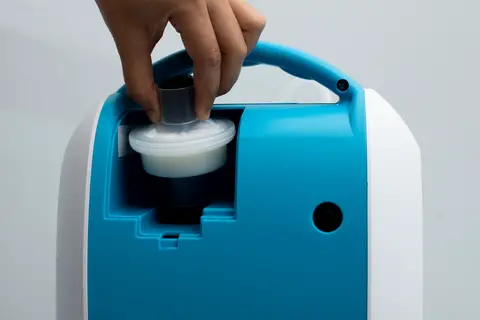
- Turn the concentrator off. Take the electrical plug out of the power socket and make sure it stays so until the cleaning process is complete.
- Your next job is to locate where the filter is. Usually, it is at the back or the sides of the concentrator unit for most brands. If you are having trouble finding it, you will need to look into the manual of the specific model that you have. (Information for some popular brands can be found in a table later in this post)
- Take the filter out and observe it. Usually, it needs to be cleaned if it has turned dark or brown from dust and other pollutants. (This means you will be cleaning your filter anywhere from twice a week to once a month.)
- Take the filter and place it under warm running tap water.
- If there are stubborn stains, you may consider using a very mild detergent. However, it is generally recommended that you clean the filter WITHOUT any soaps or harsh chemicals.
- Hang the filter afterwards in a clean area for it to air dry. Make sure it is out of reach of children, pets or pests.
- Once the filter is completely dry, place it back into the cabinet. You can now turn the concentrator on.
The things to really keep in mind here are to avoid using soaps as far as possible, and to make sure the filter is completely dry before you re-install it.
How to clean oxygen concentrator tubing
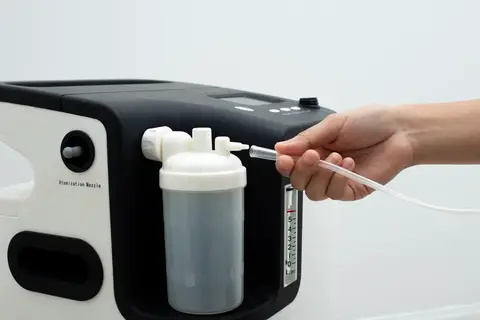
Unlike the concentrator cabinet or the filter, it is not considered practical to disinfect your oxygen tubing frequently.
Instead, the correct thing to do is to replace the entire tubing with a new sterile tube that you can get from most pharmacies.
How often you will need to replace the tube depends on the manufacturer or the brand you are using. In general, you need to replace it at least every four months.
Till it is replaced, here are a few things you should be doing:
- Clean the exterior of the tubing every time you clean the main concentrator cabinet.
For this,
- Unplug the device.
- Run a clean, damp cloth dipped in mild soapy water along the tubing.
- Repeat the process with another damp cloth dipped in plain water, and,
- Wait until it dries to use the concentrator again.
- Make sure the tubing is out of reach of pets or pests.
- Regularly check to see if there are any cracks in the tubing, as it could significantly affect the amount of oxygen that your patient is getting.
- Never soak the tubing, as it is very difficult to get the water out once it is in.
- Finally, it is recommended that the tubing you use is not longer than 25 feet in length. Long tubes provide a natural resistance to airflow, and are also more suceptible to kinking or any external damage.
How to clean an oxygen concentrator humidifier
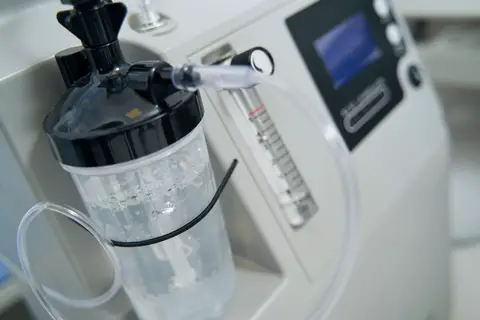
The humidifier contains water which will directly enter your lungs. If there is any contamination or infection in the humidifier, you will therefore end up with a higher risk of respiratory infection.
Follow these instructions to clean/maintain your oxygen concentrator’s humidifier:
- Replacing the humidifier’s Water
Open the humidifier’s upper lid, empty out the water and replace it frequently. Ideally, this should be done everyday, but you need to do it at least twice a week.
Make sure you are emptying the entire content of the humidifier bottle and replacing it with new water. Also make sure the water you are using is distilled/sterile, and NOT tap water. You can get distilled water from most pharmacies around you.
- Disinfecting the Humidifier Bottle
On top of regular water replacements, you need to clean your humidifier bottle every week. For this, follow these steps:
- Unplug the device.
- Take the humidifier bottle off the main cabinet.
- Empty the bottle completely.
- Clean both the inside and outside of your bottle with a mild soap or detergent. Rinse it thoroughly to ensure the odor of soaps is gone.
- Next, prepare a disinfectant solution with one part white vinegar and three parts water. Dip the entire bottle in this solution for at least 20-30 minutes.
- Rinse the bottle thoroughly under warm running water.
- Dry the bottle in a clean area.
- Refill the bottle with distilled water up to the mark mentioned in the bottle and replace it.
- If you are not going to use the bottle immediately, place it securely in a plastic bag.
Keep in mind to not touch the inside of the humidifier bottle once it is clean, and to regularly check the bottle for any cracks, damage. Also keep an eye out for any discoloration in the water, which is an indication to replace it immediately.
How to clean a nasal cannula
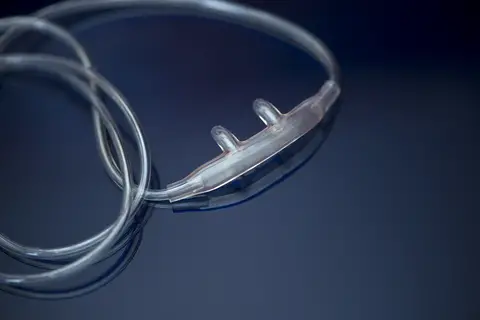
It is typically recommended that you clean your nasal cannula every day, and replace it monthly. To clean it, follow these steps:
- Disconect the cannula. You may connect another one to use during the cleaning process.
- Prepare a solution with a small amount of mild soap and water.
- Dip a soft fabric or cotton swab in the solution and rinse it gently.
- Use this fabric or swab to gently rub off any dirt, dust or grime in the cannula. Be thorough and make sure to cover all surfaces from the point where the single tube divides all the way to the two nasal prongs.
- After it dries, use another piece of damp fabric to clean off the surface again and remove any remaining soap.
- After it dries up, reconnect the cannula. Make sure to not touch the two prongs after they are cleaned.
Here are some extra general maintenance tips for nasal cannula:
- Avoid placing your cannula on unclean surfaces, like your tabletop, when not in use. Instead, place it securely inside a clean plastic bag.
- Avoid touching the prongs as far as possible.
- Although it is possible to disinfect the cannula using a vinegar solution, we recommend changing the cannula every month instead.
- Never use the same cannula for two different people.
- If the cannula looks visibly soiled (with dirt, grime or even nasal secretions), replace it immediately.
How to clean an oxygen mask

Cleaning an oxygen face mask is quite similar to cleaning your nasal cannula. You can follow these simple steps:
- Take the mask off of the oxygen tubing.
- In a tray, prepare a solution of warm water with a mild liquid soap or detergent.
- Soak the mask in the solution.
- Rinsk the mask under running water.
- Now, prepare another disinfectant solution with 1 part vinegar and 3 parts water. Some manufacturers may have specified a different concentration of vingar, so we recommend checking your user manual before proceeding with this step.
- Let the mask soak in the disinfectant solution for 20 minutes, then rinse again under warm water.
- Let it air dry completely on a clean surface. You can either use it or store it safely inside an airtight plastic bag.
Remember that disinfecting your mask is a temporary process that we recommend on a weekly basis. You should be changing your mask every month.
General Maintenance instructions
Here are some general instructions for proper use and maintenance of your oxygen concentrator:
- Make sure the room you are living in is not too dusty. If so, consider investing in an air purifier, or look into general dust reduction strategies. This will help prolong the life of your concentrator’s filter.
- Upon purchase, check your user manual properly on how to take care of your device, and keep it safe for future reference.
- Understand that your concentrator is a medical equipment, and therefore make sure to consult your care provider before making any adjustments in its settings.
- Always ensure you maintain proper hand hygiene while handling your oxygen concentrator.
- Do not use harsh chemicals or soaps to clean your concentrator.
- Never allow any liquids or spray to get inside the crevices and openings of your oxygen concentrator.
Brand Specific Information
The instructions we mentioned above are based on general principles of oxygen concentrator care. Specific brands may have slight differences. In the table below, you can find relevant information for five popular brands: Invacare, Devilbliss, Visionaire 5, Inogen and Phillips.
| SN | Brand | Cleaning Instructions for the Cabinet | Location of Filter | User Manual Link |
| 1 | Invacare | Clean the device with a damp cloth dipped in mild soapy water, then dry with another clean fabric. | Back of the cabinet | Invacare Manual |
| 2. | Devilbliss | Same as Above | Back of the cabinet | DeVilbliss Manual |
| 3. | Visionaire 5 | Same as Above, but Visionaire has specifically asked not to use alcohol based products for cleaning. | “No need to clean or replace” the filter | Visionaire Manual |
| 4. | Inogen | Clean with mild liquid detergent as above. | Behind the cannula nozzle fitting. | Inogen Manual |
| 5. | Phillips (Everflo) | Same as above. | On the back of the cabinet. | Everflo Manual |
How often should an oxygen concentrator be cleaned?
The exterior of an oxygen concentrator needs to be cleaned weekly. It should also be cleaned any time dirt, dust or grime is visible on it. The humidifier bottle should also be cleaned weekly, while the nasal cannula should be cleaned daily and replaced monthly.
How often should oxygen concentrator filters be cleaned?
An oxygen concentrator filter needs to be cleaned twice a week to once a month depending on the dust level in your room.
We don’t recommend going more than a month without cleaning your oxygen concentrator filter.
If more than one person is using the concentrator, you should change it for every new patient.
How often should I change the filter of my oxygen concentrator?
The filter on an oxygen concentrator should be changed every four months for most major brands. However, you also need to mandatorily change it if you are using the concentrator for a different patient.
Usually, all brands come with a replacement filter. You can also use this replacement filter while the one previously in use is being cleaned.
How often should you change the tubing on your oxygen concentrator?
The tubing on an oxygen concentrator needs to be completely replaced every four to six months. In addition to this, the tubing should be cleaned every week.
If there is any sign of damage to the tubing (obstruction, kinking or leakage, for example), you need to replace it immediately.
You also need to change the tubing whenever you use it for different patients.
When should I clean/replace my nasal cannula and oxygen mask?
A nasal cannula should be replaced every month and cleaned everyday. Similarly, oxygen masks need to be cleaned weekly and replaced monthly.
What is the difference between green and clear oxygen tubing?
Green and clear oxygen tubing are essentially the same when it comes to their function of letting oxygen flow from one point to another when attached to an oxygen concentrator. The only reason some tubes are made green is so that people can see it better and therefore don’t accidentally trip or fall.
